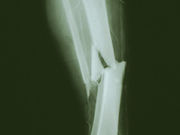Lower femoral neck bone mineral density and T scores for fracture versus non-fracture group
FRIDAY, May 11, 2018 (HealthDay News) — For patients with osteopenia or osteoporosis, taking a bisphosphonate (BP) drug holiday is associated with increased risk of fracture for patients with lower femoral neck bone mineral density (BMD) or T scores, according to a recent study published in Endocrine Practice.
Brittany Bindon, M.D., from the University of Chicago, and colleagues conducted a retrospective chart review of 401 patients with osteopenia or osteoporosis who began a BP drug holiday from 2004 to 2013.
The researchers found that 15.4 percent of the patients developed a fracture during follow-up. Yearly fracture incidence varied from 3.7 to 9.9 percent, peaking during years four and five at 9.9 and 9.8 percent, respectively. The fracture group had a higher age than the non-fracture group, although the difference was not significant (69.24 ± 12.26 years versus 66.42 ± 10.18 years; P = 0.09). At baseline, the fracture group had lower femoral neck BMD (0.75 ± 0.12 g/cm² versus 0.79 ± 0.10 g/cm²; P = 0.03) and T scores (−2.13 ± 0.99 versus −1.78 ± 0.79; P = 0.01) than the non-fracture group.
“Patients who begin BP drug holidays at high risk of fracture based on BMD, age, or other clinical risk factors warrant close follow-up, especially as its duration lengthens,” the authors write. “Fracture risk analysis needs to be regularly assessed during the drug holiday and treatment resumed accordingly.”
One author disclosed financial ties to Amgen.
Copyright © 2018 HealthDay. All rights reserved.








